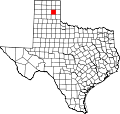Pampa, Texas | |
|---|---|
City | |
 Pampa business district | |
 | |
| Coordinates: 35°32′52″N100°57′54″W / 35.54778°N 100.96500°W [1] | |
| Country | United States |
| State | Texas |
| County | Gray |
| Government | |
| • Type | Council-Manager |
| Area | |
• Total | 9.02 sq mi (23.36 km2) |
| • Land | 9.02 sq mi (23.36 km2) |
| • Water | 0 sq mi (0.00 km2) |
| Elevation | 3,225 ft (983 m) |
| Population | |
• Total | 16,867 |
| • Density | 1,870.1/sq mi (722.05/km2) |
| Time zone | UTC-6 (Central (CST)) |
| • Summer (DST) | UTC-5 (CDT) |
| ZIP codes | 79065-79066 |
| Area code | 806 |
| FIPS code | 48-54912 [4] |
| GNIS feature ID = | 1364740 [1] |
| Website | www |


Pampa (from the Quechua: pampa, meaning "plain") is a city in Gray County, Texas, United States. Its population was 16,867 as of the 2020 census. [3] Pampa is the county seat of Gray County and is the principal city of the Pampa micropolitan statistical area, which includes both Gray and Roberts Counties. [5] Pampa is named after the Pampas Lowlands in Argentina, Uruguay, and southern Brazil.
Contents
- History
- 1995 tornado
- Geography
- Demographics
- 2020 census
- 2010 Census
- 2000 Census
- Media
- Education
- Library
- Climate
- Notable people
- References
- External links
Pampa hosts the Top o' Texas Rodeo each year in July, which brings competitors from Texas and the surrounding states to Gray County. The White Deer Land Company Museum, which showcases ranching exhibits, is located in downtown Pampa. [6]
